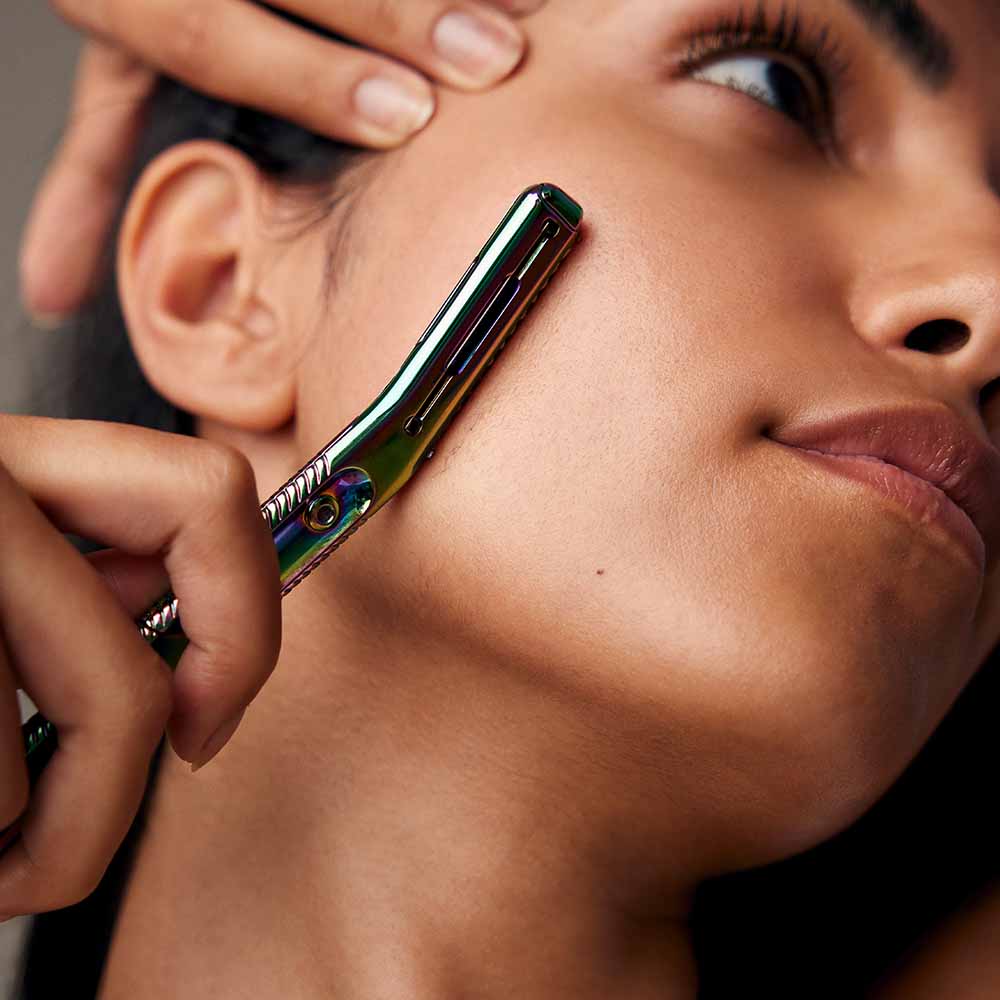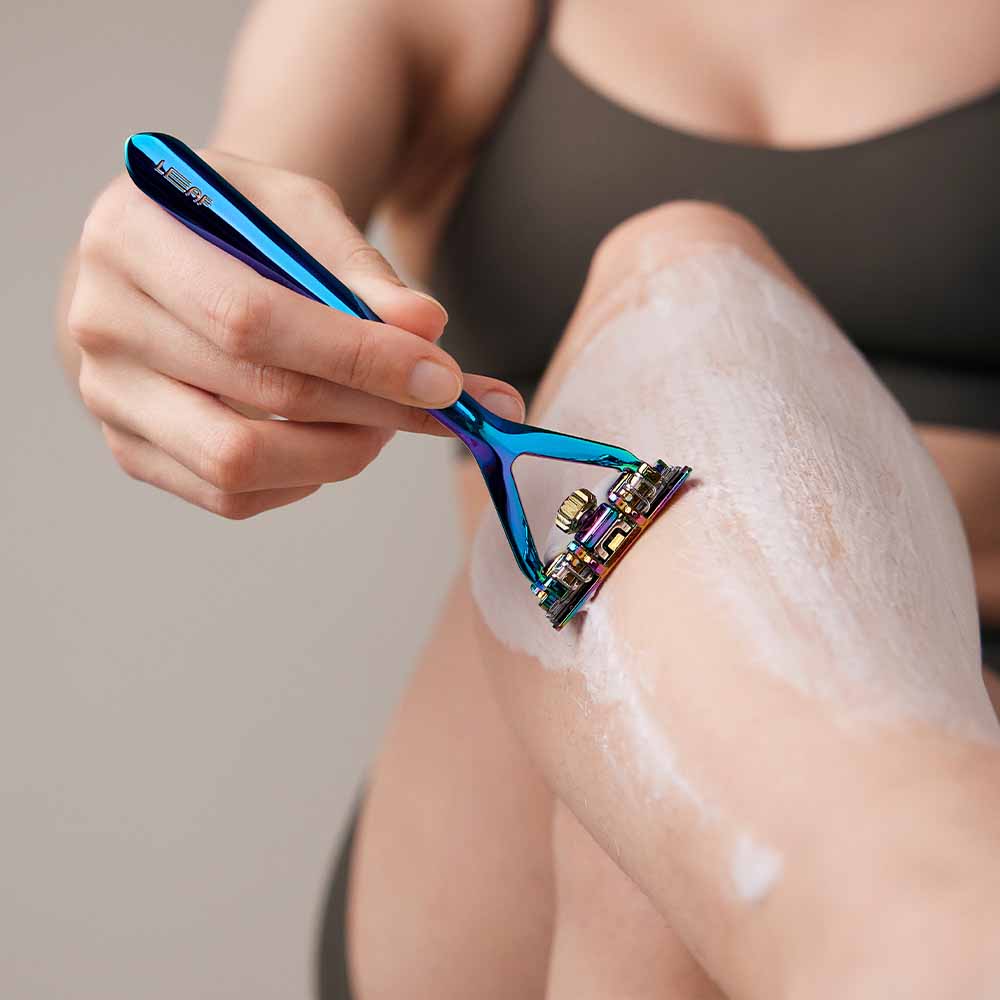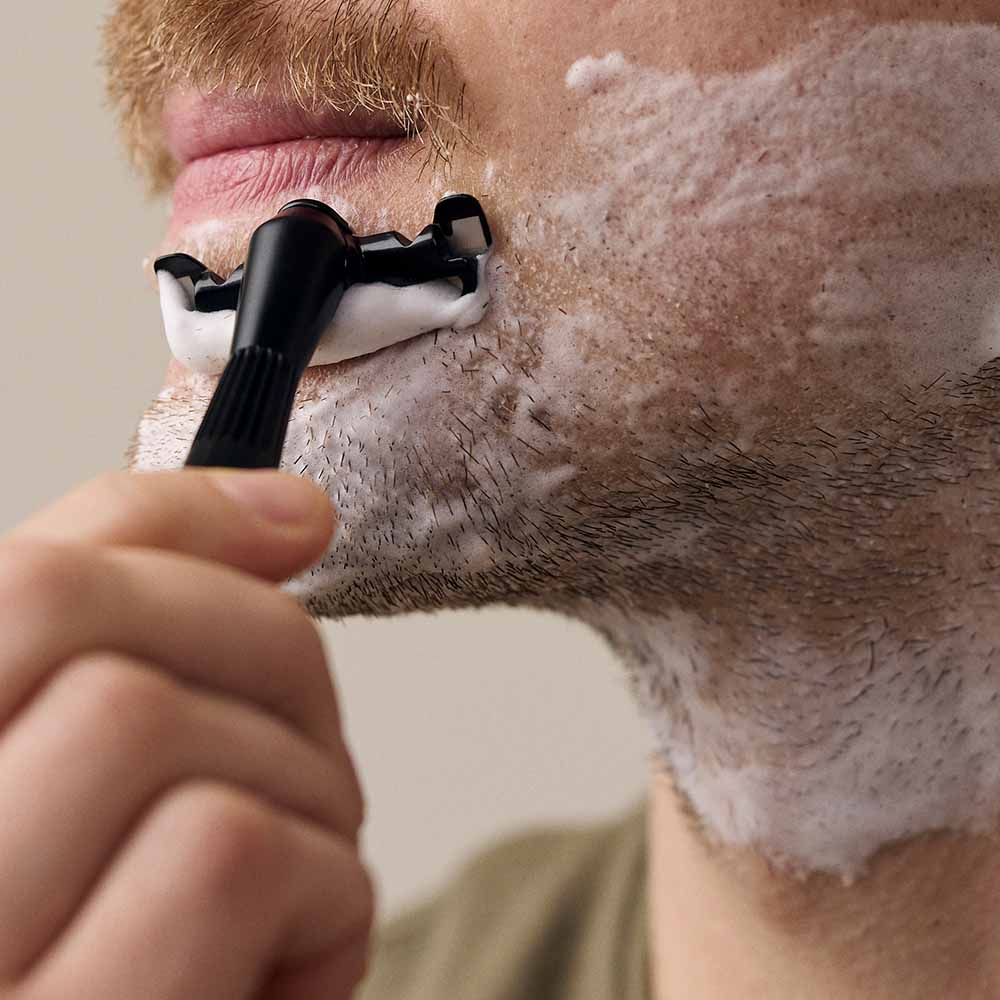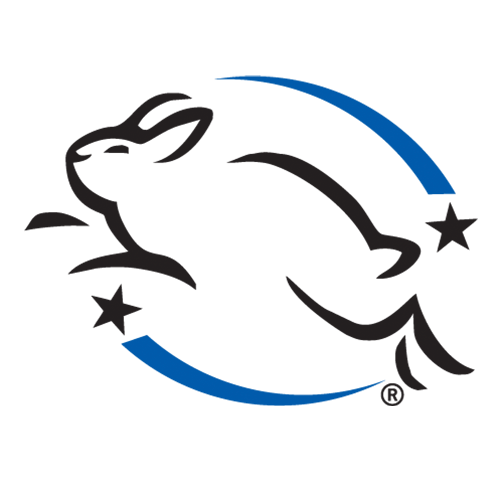GETTING STARTED
Start here and review the below information. Next, watch the videos to see your new tool in action. And if you ever have any questions please reach out to us at support@leafshave.com.
HOW TO SET UP YOUR TOOL
There are two pieces to replace when you refill your Dermaplaner tool: the blade, and the blade guard.
- Your tool comes with your first blade guard already installed. You simply need to unwrap a fresh blade and install that.
- Don’t discard any of the items located under the tool in the packaging. We include 2 replacement blades, 1 replacement blade guard, and 1 precision clip. These are all important. Refills are available when you’re ready to restock, and replacement Precision
- Clips are available if you lose yours.
To load the first blade:
- Thumb the head open, unwrap a blade, and insert it *between* the flaps of the blade guard. This is very important: do not simply lay the blade on top of the blade guard and close the head... insert the blade *between* the flaps of the blade guard. If you need a visual, please watch the above videos so that you understand how to correctly load the blade.
- Push the blade forward once it’s between the flaps of the blade guard and press it down from the back. This will be a tight, friction fit. This forces the edge of the blade hard up against the inside of the scallops of the blade guard.
- The blade’s edge will be completely encompassed by the blade guard’s scallops, it will not be fully exposed on either side.
- When you’re ready to refill your tool, reach behind the blade and push it forward while pulling up, it will pop out, it may take some effort to release from the friction fit.
- Then turn the dermaplaner tool over and use a coin or other thin object to push out the blade guard. Place the used blade and blade guard in your Recycling Tin.
- Install a new blade guard by inserting the short leg of the guard through the slot from inside the dermaplaner head. Friction will hold it in place.
- Finally, unwrap and load a fresh blade, close the head, and enjoy.
HOW TO DERMAPLANE AT HOME
Dermaplaning at home is a skincare technique where you use a sharp, guarded blade to gently scrape off the top layer of dead skin cells and fine vellus hair (peach fuzz) from your face. This exfoliation process aims to leave the skin smoother and brighter. It’s important tot follow proper hygiene and safety guidelines to avoid irritation or cuts. And to keep in mind contraindications.
PREPARATION
- Remove makeup and skincare products prior to dermaplaning.
- Thoroughly clean your face’s skin with a non-exfoliating cleanser.
- Apply a small amount of Shave Oil to your skin this will help the blade glide.
DERMAPLANE
- Bring the tool to your skin: Hold your skin taut behind the tool. Place the blade at a 45° angle against your skin.
- Begin dermaplaning: Use light pressure and move in short, feathery strokes. Start high on your cheekbone and move inward / down along your cheek and jawline.
- Address areas of concern: Continue along your forehead moving downward. Use above your lip and along your chin as desired. Avoid use on your nose. Rinse or wipe the blade throughout use and most importantly take your time.
AFTER CARE
- When you’re finished, rinse your skin and apply Calming Serum for a layer of protection and soothing. Avoid direct sunlight immediately after dermaplaning and consider use of a SPF. Avoid chemical exfoliation products immediately after dermaplaning.
- Rinse your tool thoroughly. Remove the blade and rinse the blade, disinfecting it with a wipe of rubbing alcohol. Rinse and disinfect the blade-guard while keeping it in the tool. Re-load the blade for next use, unless you are refilling it with a fresh blade and guard. Don’t use your blade and guard more than three times—prioritizing fresh and clean tools when working with your face’s skin.
AVOID DERMAPLANING IF...
Please consult your dermatologist if you ever have questions about whether using an at-home tool like this is a good fit. Potential contraindications can include:
❌ History of skin irritation
❌ Rosacea
❌ Active acne
❌ Eczema
❌ Psoriasis
❌ Active sunburn
CAUTIONS
- Use each blade and blade-guard up to three times before refilling your tool.
- Before using your Dermaplaner, read through all instructions carefully, and watch all the videos closely.
- Exercise caution when handling blades, loading blades, and using the razor. The blades are sharp and may cause injury if not loaded and used properly. You should not use the razor if you are unable to safely load and handle the blades.
- Please keep the Dermaplaner and blades out of reach of children.
- Do not use the Dermaplaner unless both the blade and the blade-guard are properly installed. To understand how both of these refillable items are properly installed, review these instructions and watch the instructional videos below.
- If you need support of any kind, or if you have any questions or concerns, please reach out to support@leafshave.com and discontinue use of your tool until your issue is resolved.
Use only as directed.
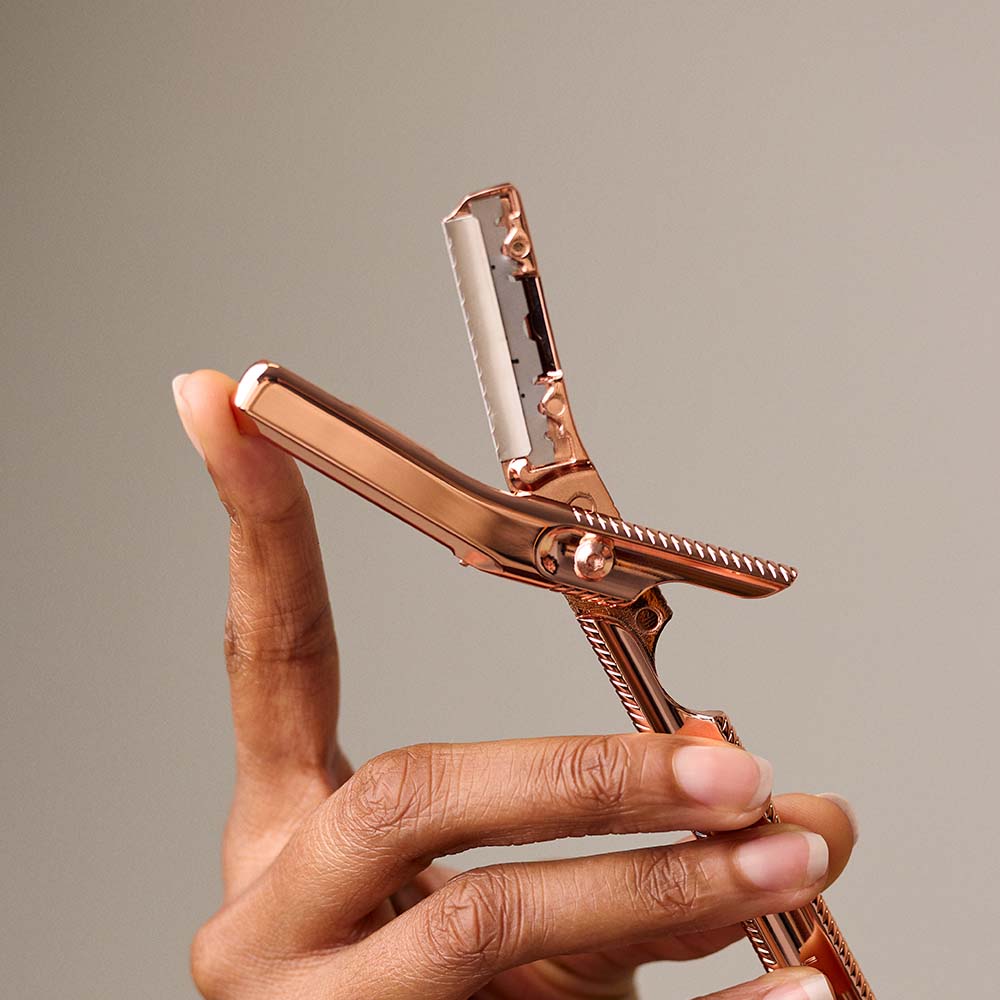
GETTING TO KNOW THE BLADES & GUARDS
Your Leaf Shave Dermaplaner has two separate pieces that make up a blade refill: the safety blade, and the blade guard. Home dermaplaning blades are “guarded” which means that the edge of the blade has a wire or guard welded over the edge.
This means that the full bare blade’s edge is never allowed to fully contact your skin, this is the safety feature that makes these tools easier and safer to use at home. It’s important that you correctly load the blade, please watch the above video setting up your new tool.
Your tool is the first at-home dermaplaning tool that uses safety razor blades which are non-proprietary and very inexpensive while being very sharp. In order to make the tool work with these blades, one of the innovations in this tool is the blade guard. This very thin steel piece wraps around the edge of the blade, fully encapsulating it with the scalloped openings.
Your tool comes with a blade guard installed so that you only need to load a blade to get started. We highly recommend watching the above getting started videos to understand how to load and unload the blades, and the blade guards.
You must use the blade guard along with the blade, the tool will not work with just a blade loaded. Refills are available with both pieces together, or as just the blade guards if you already have blades.
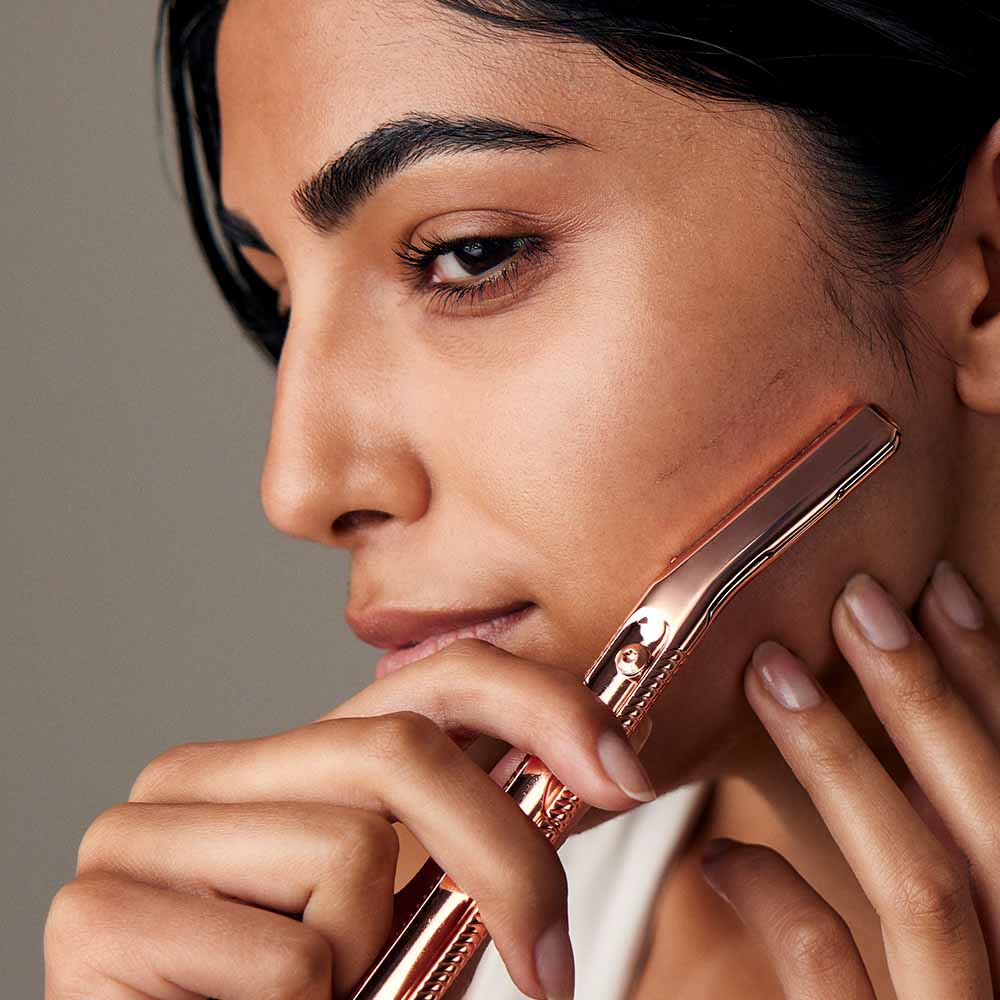
HOW THIS DIFFERS FROM IN CLINIC PROCEDURES
Dermaplaning is a procedure often performed in a clinic at the hands of an esthetician or dermatologist. These professionals use a bare scalpel blade and scrape away dead skin cells and peach fuzz on your hair.
In the past decade, tools have started becoming available that allow people to perform a version of dermaplaning safely, at home. These tools, like the Leaf Dermaplaner, characteristically have a guard wrapped around the blade’s edge which lessens the risk of unintentional injury and allows for an easier glide of the blade across your skin.
You will achieve a lighter level of mechanical exfoliation due to the guarded blade. Many people use at-home tools as a supplimental process in between more spread-out clinic visits for deeper exfoliation. And others still are simply looking to remove the peach fuzz hair on their face to allow better absorption of skincare and application of makeup.
FAQ
Common getting started questions.
HOW IS DERMAPLANING DIFFERENT FROM SHAVING?
Though they have very similar methods, dermaplaning uses a single blade and cuts the hair at a different angle than shaving. The purpose is to exfoliate and remove fine hair for smoother, brighter skin, and to achieve a more even skin tone instead of just hair removal.
WILL I NICK MYSELF DERMAPLANING?
While there is always a risk of nicks when dermaplaning with a blade, the Leaf Dermaplaner covers the full length of the safety blade with a scalloped-guard.
This allows you to use a sharp, effective blade for dermaplaning at-home safely.
HOW OFTEN SHOULD I DERMAPLANE?
We suggest using Dermaplaner every one to four weeks or as needed. Some people luxuriate in the at-home process only a few times a year. So listen to your skin and needs.
HOW LONG DO THE BLADES LAST?
We recommend refilling your Dermaplaner every three uses (give or take) or once a month—whatever comes first. It's always best to use clean fresh blades when home dermaplaning.
WILL THE HAIR GROW BACK THICKER?
No. Just like shaving, dermaplaning will not make your hair grow back thicker or darker. Consult with your dermatologist if you have specific questions about your hair and skin.
HOW TO CARE FOR YOUR TOOL
Your new Dermaplaner is a tool that you want to keep around for a long time. With proper care, that will be the case. Don’t feel intimidated by caring for your razor, though, it’s not onerous. Live by this simple rule: keep it at a base level of clean.
CARE DURING AND AFTER USE
DURING
While using Dermaplaner, keep the edges clear of hair and skin cells as needed. Either gently wipe on a soft cloth or run quickly under water.
AFTER
After you finish using Dermaplaner, remove the blade, rinse and dry it. With the head of the tool flipped open, rinse water through the blade-guard from within the tool. If desired, you can disinfect the blade and blade-guard with rubbing alcohol.
You can reinstall the blade for next use if you're using the same blade next time. If you're using a fresh blade next time, leave your tool empty until then, or unwrap a fresh blade and install that.
LONG-TERM CARE
Periodically, as needed, give your tool a deeper clean. We suggest using an old-toothbrush that has been designated as your 'razor cleaning toothbrush.'
First, remove any blade and blade-guard that is installed into your tool.
Then, apply a small amount of dish soap onto the toothbrush. Mixing with water, scrub the tool all over, in all the nooks and crannies. Remove any residue that may be left over from use.
Dry using a soft-cloth or towel. Reinstall a fresh blade-guard and blade for your next use.
EXPLORE COMMUNITIES
Looking for more context around where you’re shaving? Visit our community pages.




